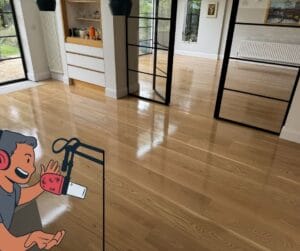Are you thinking about a makeover for your room? You are considering having wood floor restoration but need to decorate and know whether to decorate before or after. Understanding the process would be better, right?… After all, if you get the process wrong, the work you are now starting is at risk of damaging the work you have already done.
For many projects, it is clear one thing must happen before the other thing. For example: You should Insulate before you instal the drywall. But what about other projects that seem like a close choice?
Laying floors or refinishing and interior painting are two projects that normally happen around the same time. So, when should you paint the walls… before or after laying or refinishing the floors? Each side has its benefits.
However, most of it depends on different factors… some may fit your project:
Starting the floors first:
- Floors determine the room’s look; you should do the walls afterwards.
- Dust from floor sanding won’t collect on your freshly painted walls.
- Paint is reasonably easy to get off a well-finished floor.
Doing the walls first:
- Light paint on a wood floor being restored will be sanded out.
- It will protect walls if you will be doing some heavy sanding is expected.
- You don’t need to worry about dropping paint on the subfloor (before laying the wood floor)
Pros & Cons of Installing or restoring floors before painting walls:
Pros
- Easier for you to match the wall colour to the floor than the other way around.
- Damage that could happen to walls from your floor sander is easier to paint over than the other way around.
- Dust from wood floor sanding won’t damage newly painted walls.
Cons
- You might drip paint on your newly installed or finished wood flooring.
- You will need complete and well-secured drop cloths across the whole of your wood floor.
Pros & cons of Installing or restoring floors before painting wallsExplained:
If you have no floor coverings and only a subfloor, then you will benefit by painting the walls and ceiling before installing the new wood floor. You can paint with complete freedom, even using a paint sprayer, as spillages rarely cause much damage. If this case, the choice is pretty much made for you already.
- Which surface’s appearance is a more permanent one: walls or floor? It’s more difficult to re-stain a floor and change its colour to match the wall colour. But you can change the wall colours overnight.
- When you run a wood floor sander around your room, there is the chance of scuffing up your freshly painted walls. Even if you have removed the baseboards… due to the extreme activity, you might gouge or scrape your newly painted walls.
- If you drip on a fully finished, sealed floor and get to the drip within a few seconds, it’s like it never happened. If the paint dries, you can sometimes peel off the drop with a fingernail. Even so, the pigment can stain the finished wood floor’s surface. Do you want to take the chance after already investing so much money and time into restoring the wood floor?
- Wood floor sanding can produce a large amount of dust. This dust settles on all surfaces. Unless you hire a flooring professional, they have good dust extraction systems to help contain the dust.
Pros & Cons of painting walls and skirts before installing or restoring floors:
Pros
- Painting tools and activities that could damage wood flooring you can sand.
- Almost any paint accidents are acceptable for subfloors (before installing the wood floors), as they will cover it with the new floor.
- You can sand away light paint drips.
Cons
- Paint spillages on raw wood can be harder to clean than paint on newly finished surfaces.
- Walls will have to be protected if wood floor sanding as it will create a great deal of dust.
Pros & cons of painting walls and skirts before installing or restoring floors explained:
- You will want to paint your walls first because you may smear or drip paint on your newly finished wood floor. Wood floors are expensive and harder to fix than the walls.
- If you paint your walls first, you may think it is possible to paint and then sand out your paint drips. Paint that has dripped and hardened on a sealed surface will come off when they restore, so before restoration would be best.
- If the floor happens to be natural unfinished wood, paint can seep into the wood and stain it almost beyond repair. You would have to deeply sand into that natural wood to remove the pigment in the paint. So, even if you decide to paint the walls first, protecting your flooring from paint drips would be best.
What will suit your needs?
The end choice will depend on your needs and personal likes and dislikes. Wood floor finishing is semi-permanent. Stained wood flooring holds its colour for a long time, and it is hard to sand it all out. Your wood floor will have a specific look, whether semi-glossy or glossy or a particular hue… how your walls look should follow from there.
Whether you have finished the floor before or not, paint drips can be a concern. The best way to make sure that your flooring stays looking its best is to not get paint on it in the first place. Be sure to use a canvas dust sheet to cover all areas of your wood floor. Good dust sheets are a wise investment in your house because you can use them more than once. You have to throw away the plastic cloth’s; they can be slippery.
Looking for a floor sanding professional near you? Click on the link below:
Check out this blog to maintain your wood floor:
Download our eBook…
To learn more about caring for your wood floor!

Your Wood Floor

Written by Tracey Gilbey, Marketing
For further advice or information on our Carpet and Soft Furnishing care, please don’t hesitate to contact the Art of Clean team on 01223 901549 in Cambridge. Our services include Carpet Cleaning, Upholstery Cleaning, oriental and area Rug Cleaning, Curtain Cleaning, Patio and Driveway Pressure washing, Leather Cleaning, Stone and Tile Floor Cleaning and Wood Floor Sanding and Restoration. We also supply new flooring and carpets through our sister company Art of Flooring. Farthings Cambridge provides our Dry Cleaning service.


















